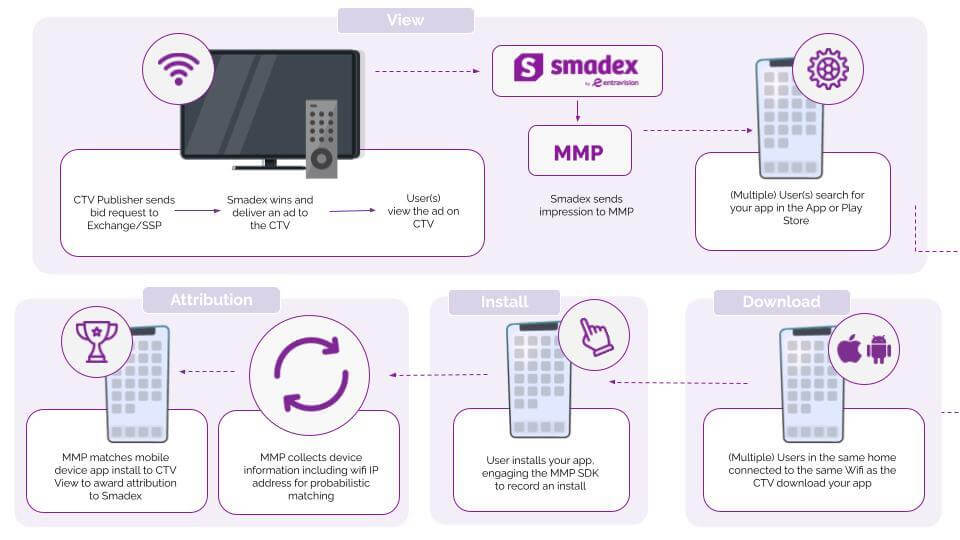Performance Power Players: Smadex on the power of Programmatic CTV for Mobile

Elisa Lozano, Senior Sales Director at Smadex, discusses how a programmatic approach to managing CTV campaigns can overcome growth pain points for mobile marketers.
First, a recap: what is Programmatic CTV?
Programmatic CTV is a data-driven, automated method of buying and delivering advertising in internet-connected streaming TV services. This method of buying CTV brings the methodology of programmatic advertising combined with the power of the big screen placement in the home and, therefore, benefits such as;
- Real-Time Bidding
- Cross-device and Data-driven Targeting
- Performance Measurement and opportunity for campaign optimization

Programmatic CTV relies on a DSP to deliver advertising in real time. The presence of an MMP ensures app install results are measurable and enables campaign optimization
For more information about how mobile marketers can utilize programmatic CTV as a growth strategy, please read the following:
What pain points can advertisers overcome using programmatic CTV?
Firstly, programmatic CTV can effectively engage customers and fulfill many different goals because of the channel’s big-screen format. For example, CTV enables advertisers to implement full-funnel marketing strategies, retarget users, and/or boost mobile campaigns. CTV audiences can also be retargeted via mobile to encourage app installations or re-activate users who have lapsed and, as a result, grow LifeTime Value and ROAS.
Secondly, CTV provides the opportunity to reach a wider audience. Thanks to the broad range of inventories available outside of mobile campaigns, there is a chance of reaching incremental audiences in addition to mobile campaigns. However, the popularity and usage of CTV traffic are rapidly and significantly growing. If advertisers consider testing CTV starting sooner rather than later, ensuring they get the desired placements could be beneficial.
Thirdly, with CTV, advertisers can control who they are reaching, offering more control than linear TV for multiple reasons. One of the main advantages is the ability to target specific audiences, which is impossible through linear TV. By buying CTV inventory through programmatic means, advertisers can ensure that their ads reach the right people at the right time.
Fourth, CTV allows you to re-engage users, helping you to build brand loyalty and increase the chances of retention.
Finally, CTV provides the ability to analyze and optimize creatives. By tracking the performance of different ad variations, advertisers can identify which ones resonate better with specific target audiences and make data-driven decisions to improve their campaign results.
Of course, one huge benefit of CTV is the ability to measure campaign impact, as discussed below.
What advice do you have for measuring the value of CTV?
This is a huge topic of discussion because it’s extremely difficult to track linear TV. CTV campaigns, on the other hand, not only provide their own performance but also contribute to the success of mobile User Acquisition campaigns. Through an impression tracker via an MMP, advertisers can track the effectiveness of even lower funnel events of CTV campaigns.
When evaluating performance, advertisers should consider various factors such as media spend, conversions, etc. If running via Smadex, advertisers can analyze the impact of a CTV campaign by examining the users who were impacted by CTV and then converted through the mobile campaign.
There is also an opportunity to look at assisted conversions by analyzing First Party Data and monitoring the impression-to-install time trend. This gives advertisers a comprehensive understanding of how the CTV campaign affects other campaigns.
After running many CTV campaigns at Smadex, we have noticed a decrease in the time from impression to install KPIs as campaigns are optimized. This provides evidence of CTV’s positive halo impact on other marketing campaigns.
What CTV inventory is currently available programmatically?
Both Open Market and Private Market Place (PMP) traffic is available on Connected TV (CTV), so depending on the strategy, advertisers can choose what is most appropriate. There is also an option for advertisers to ensure that their CTV campaigns run exclusively on premium ad inventory, even with smaller budgets, if that fits their goals.
Premium inventory such as CNN, Fox, and Hulu is available through the open market, which can be accessed with specific targeting configurations.
Open Market Place
CTV inventory is available to all advertisers via a competitive buying model where buyers bid in the same ad placements in real time. Open Market Place inventory usually has a wide range of publishers available, and usually, the prices are lower than a Private Market Place, which offers exclusive deals on specific content. Advertisers should be aware that there is less control over the quality and context of where their brand could surface when buying Open Market Place inventory.
Private Market Place (PMP)
This buying method involves a direct deal between a specific publisher and a select group of advertisers or agencies. The inventory is generally premium content that may not be available via the Open Market Place and, therefore, offers advertisers the chance to be placed beside specific shows and reach their specific audience. This offers greater control of the ad placements but, as a result, can be a more expensive option.
Find out more about optimizing CTV campaigns for mobile in our new guide;
How can advertisers ensure campaigns run on premium ad inventory?
Advertisers can ensure that their CTV campaigns run on premium inventory by doing a few things:
- First, focus on targeting specific publishers or platforms known for providing high-quality content and premium ad placements. This helps to ensure that ads are shown in a brand-safe and reputable environment.
- Secondly, advertisers can utilize programmatic advertising systems such as machine learning algorithms that offer advanced targeting and placement options by finding ideal inventories and creative variants. These tools allow advertisers to specify their preferred ad inventory and avoid lower-quality placements to improve results overall.
- Lastly, advertisers can work with trusted ad networks or media partners who have established relationships with premium publishers. These partnerships can secure access to premium ad inventory at more affordable rates or as part of bundled deals.
Can programmatic CTV re-engage lapsed mobile customers?
The ability to re-engage audiences via CTV is one of Smadex’s specific benefits. Increasingly, it is clear that Connected TV offers marketers a powerful channel for executing full-funnel strategies. One of the specific tactics is the ability to target users who have previously installed an app.
Our clients only need to provide a list of IPs or device IDs associated with their target users. With this information, Smadex’s advanced technology will identify the CTV devices these people are using, which means we can deliver impactful advertising messages directly to them.
For measurement, we have implemented methods to track and evaluate the effectiveness of these CTV campaigns. We can provide insights into the success of our advertisers’ re-engagement efforts via CTV by analyzing user behavior, engagement metrics, and install-to-conversion times.
Whether clients want to bring back lapsed customers or reengage existing users, we can help accomplish those goals and fulfill other KPIs.
Any recommendations for testing CTV campaigns?
Regarding the time for testing, we recommend brands allocate a similar time and budget as they would to a Mobile UA campaign. This typically takes around 4 – 6 weeks, although with CTV, the testing time could be shorter due to the smaller inventory available to explore in the CTV space.
As for budget, we’d recommend allocating a minimum budget of at least $1000 per day for a test. This will allow for Machine Learning algorithms to optimize and maximize their potential for success.
About Elisa Lozano
Elisa Lozano is an expert in mobile marketing through channels like programmatic and CTV. She has worked with some of the largest apps in every category to help drive growth and revenue through in-app advertising and CTV and branding campaigns. Elisa recently joined the team at Smadex, a leader in the growth marketing space, to help manage and grow partnerships to drive new users and engagement for apps globally.
Further Reading
The Mobile Marketers CTV Playbook
The Marketer’s Guide to Real-Time Bidding in the Streaming Ecosystem
Report: The Definitive Guide to Programmatic Streaming TV for Performance Marketers

